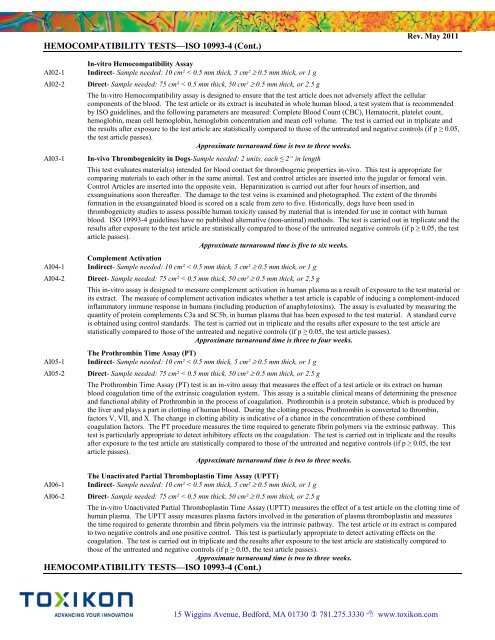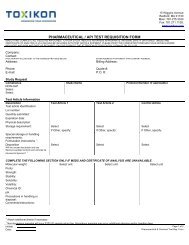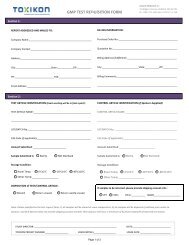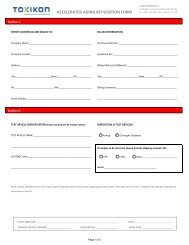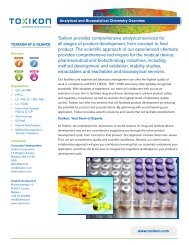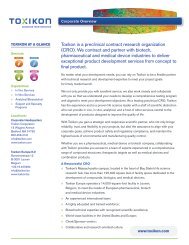Medical Device Testing Guide - Toxikon Corporation
Medical Device Testing Guide - Toxikon Corporation
Medical Device Testing Guide - Toxikon Corporation
You also want an ePaper? Increase the reach of your titles
YUMPU automatically turns print PDFs into web optimized ePapers that Google loves.
HEMOCOMPATIBILITY TESTS—ISO 10993-4 (Cont.)<br />
Rev. May 2011<br />
AI02-1<br />
AI02-2<br />
AI03-1<br />
AI04-1<br />
AI04-2<br />
AI05-1<br />
AI05-2<br />
In-vitro Hemocompatibility Assay<br />
Indirect- Sample needed: 10 cm² < 0.5 mm thick, 5 cm² 0.5 mm thick, or 1 g<br />
Direct- Sample needed: 75 cm² < 0.5 mm thick, 50 cm² 0.5 mm thick, or 2.5 g<br />
The In-vitro Hemocompatibility assay is designed to ensure that the test article does not adversely affect the cellular<br />
components of the blood. The test article or its extract is incubated in whole human blood, a test system that is recommended<br />
by ISO guidelines, and the following parameters are measured: Complete Blood Count (CBC), Hematocrit, platelet count,<br />
hemoglobin, mean cell hemoglobin, hemoglobin concentration and mean cell volume. The test is carried out in triplicate and<br />
the results after exposure to the test article are statistically compared to those of the untreated and negative controls (if p ≥ 0.05,<br />
the test article passes).<br />
Approximate turnaround time is two to three weeks.<br />
In-vivo Thrombogenicity in Dogs-Sample needed: 2 units, each ≤ 2“ in length<br />
This test evaluates material(s) intended for blood contact for thrombogenic properties in-vivo. This test is appropriate for<br />
comparing materials to each other in the same animal. Test and control articles are inserted into the jugular or femoral vein.<br />
Control Articles are inserted into the opposite vein. Heparinization is carried out after four hours of insertion, and<br />
exsanguinations soon thereafter. The damage to the test veins is examined and photographed. The extent of the thrombi<br />
formation in the exsanguinated blood is scored on a scale from zero to five. Historically, dogs have been used in<br />
thrombogenicity studies to assess possible human toxicity caused by material that is intended for use in contact with human<br />
blood. ISO 10993-4 guidelines have no published alternative (non-animal) methods. The test is carried out in triplicate and the<br />
results after exposure to the test article are statistically compared to those of the untreated negative controls (if p ≥ 0.05, the test<br />
article passes).<br />
Approximate turnaround time is five to six weeks.<br />
Complement Activation<br />
Indirect- Sample needed: 10 cm² < 0.5 mm thick, 5 cm² 0.5 mm thick, or 1 g<br />
Direct- Sample needed: 75 cm² < 0.5 mm thick, 50 cm² 0.5 mm thick, or 2.5 g<br />
This in-vitro assay is designed to measure complement activation in human plasma as a result of exposure to the test material or<br />
its extract. The measure of complement activation indicates whether a test article is capable of inducing a complement-induced<br />
inflammatory immune response in humans (including production of anaphylotoxins). The assay is evaluated by measuring the<br />
quantity of protein complements C3a and SC5b, in human plasma that has been exposed to the test material. A standard curve<br />
is obtained using control standards. The test is carried out in triplicate and the results after exposure to the test article are<br />
statistically compared to those of the untreated and negative controls (if p ≥ 0.05, the test article passes).<br />
Approximate turnaround time is three to four weeks.<br />
The Prothrombin Time Assay (PT)<br />
Indirect- Sample needed: 10 cm² < 0.5 mm thick, 5 cm² 0.5 mm thick, or 1 g<br />
Direct- Sample needed: 75 cm² < 0.5 mm thick, 50 cm² 0.5 mm thick, or 2.5 g<br />
The Prothrombin Time Assay (PT) test is an in-vitro assay that measures the effect of a test article or its extract on human<br />
blood coagulation time of the extrinsic coagulation system. This assay is a suitable clinical means of determining the presence<br />
and functional ability of Prothrombin in the process of coagulation. Prothrombin is a protein substance, which is produced by<br />
the liver and plays a part in clotting of human blood. During the clotting process, Prothrombin is converted to thrombin,<br />
factors V, VII, and X. The change in clotting ability is indicative of a chance in the concentration of these combined<br />
coagulation factors. The PT procedure measures the time required to generate fibrin polymers via the extrinsic pathway. This<br />
test is particularly appropriate to detect inhibitory effects on the coagulation. The test is carried out in triplicate and the results<br />
after exposure to the test article are statistically compared to those of the untreated and negative controls (if p ≥ 0.05, the test<br />
article passes).<br />
Approximate turnaround time is two to three weeks.<br />
AI06-1<br />
AI06-2<br />
The Unactivated Partial Thromboplastin Time Assay (UPTT)<br />
Indirect- Sample needed: 10 cm² < 0.5 mm thick, 5 cm² 0.5 mm thick, or 1 g<br />
Direct- Sample needed: 75 cm² < 0.5 mm thick, 50 cm² 0.5 mm thick, or 2.5 g<br />
The in-vitro Unactivated Partial Thromboplastin Time Assay (UPTT) measures the effect of a test article on the clotting time of<br />
human plasma. The UPTT assay measures plasma factors involved in the generation of plasma thromboplastin and measures<br />
the time required to generate thrombin and fibrin polymers via the intrinsic pathway. The test article or its extract is compared<br />
to two negative controls and one positive control. This test is particularly appropriate to detect activating effects on the<br />
coagulation. The test is carried out in triplicate and the results after exposure to the test article are statistically compared to<br />
those of the untreated and negative controls (if p ≥ 0.05, the test article passes).<br />
Approximate turnaround time is two to three weeks.<br />
HEMOCOMPATIBILITY TESTS—ISO 10993-4 (Cont.)<br />
15 Wiggins Avenue, Bedford, MA 01730 781.275.3330 www.toxikon.com


